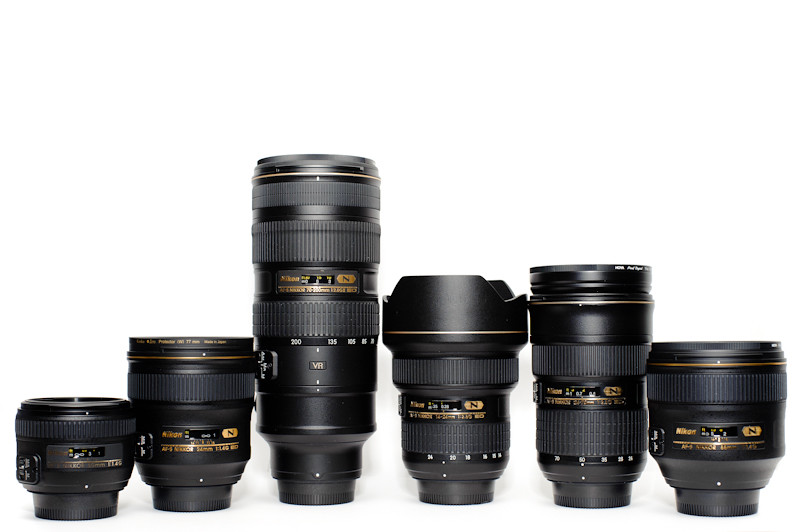If you like this post, help us share it
- Nikon 24mm f/1.4G,
- Nikon 50mm f/1.4G,
- Nikon 85mm f/1.4G,
- Nikon 14-24mm f/2.8,
- Nikon 24-70mm f/2.8 and
- Nikon 70-200mm f/2.8 VRII

Some would argue that what about the 35mm f/1.4, 105mm DC, 135mm DC, 105mm f/2.8 macro or 45mm Tilt-Shift? Well, it all comes down to your shooting style and preferences. You will need to ask yourself some important questions.
What is your budget?
This really dictates what’s available for you to choose from.
What is the purpose of this lens? What are you going to use it for?
Do you need it for travel? Portrait?
Do you need a fast lens? Do you shoot mostly under daylight or mostly indoor?
This will give you some indication on what aperture range you need.
Does it have to be a pro lens? In Canon’s term, an L lens? Does it need to be weather proof? Are you a pixel peeper who always concern with edge to edge sharpness?
If you don’t, perhaps you can get away with a kit lens which is less expensive.
I can’t say the above setup is all you ever need, but certainly they should cover 80% of your needs. I am not encouraging you to get them all, but certainly they do make a very nice setup.
Here is what I would choose for myself for the different purposes. Of cause there are other alternatives, but these are what I would choose for myself. If you are on a budget, you can replace the 50mm f/1.4 to 50mm f/1.8 and 85mm f/1.4 to 85mm f/1.8.
|
Weddings |
|
You probably want to bring everything you’ve got if you are the official photographer. If you are just a guest, bring only one lens, e.g. Nikon 24-70mm f/2.8 |
|
Studio |
|
Use the sharpest lens you’ve got for studio work. For portrait work, shoot from a focal length of 70mm+ if you are shooting for a single model. Choose a smaller focal length if you are shooting for a group. |
|
Portrait |
|
Similar to studio work, use the sharpest lens you’ve got and shoot from a focal length of 70mm+ if you are shooting for a single model. You can also add a fast wide angle lens such as the 24mm f/1.4 to mix it up. |
|
Low Light/Concert
|
|
Use the fastest lens you’ve got. Pick something with an aperture f/2.8 or lower. Depending on what you are shooting, you can choose between the 24mm f/1.4, 35mm f/1.4, 50mm f/1.4 and 85mm f/1.4. For longer range, choose the 70-200mm f/2.8 which will give you a 4 stops VR. Make sure your shutter speed is fast enough for the action on stage. |
|
Landscape |
|
Pick the sharpest lens you have got. The sharpest wide angle available is the 14-24mm f/2.8. You can choose the 17-35mm f/2.8 or 20mm f/2.8 instead if you need a lens that can fit a filter easily |
|
Macro |
|
These are the two common macro lenses. Choose either one depending on your working distance. You could also choose the older 200mm f/4 macro |
|
Travel |
|
You probably shouldn’t be carrying more than two lenses unless it is a photographic trip. You can probably add the Nikon 14-24mm or 17-35mm to the selection if you need a wide angle. |
|
Light Travel |
|
These are the smallest and lightest lenses for travel. You can narrow them down to one if you don’t want to change lenses. |
Where can I find the equipment seen on this site?
If you find this site useful and planning to purchase any of the equipment seen on this site, please show your support by purchasing your photo equipment at B&H Photo Video or through any of the affiliate links seen on this site.


how about this 2 kind of lens? purposely for weddings job & potrait.
nikkor 28mm f2.8d VS nikkor 35mm f1.8G.
Hi Eizapai,
The 35mm f/1.8 on DX camear is an adequate lens for portrait purposes. The 28mm f/2.8 on a FX camera is a medium wide angle lens which can provide good coverage for weddings. What is missing could be on the tele side, but that is totally depending on your shooting style. The 28mm might not be the sharpest lens, but it will serve you right.